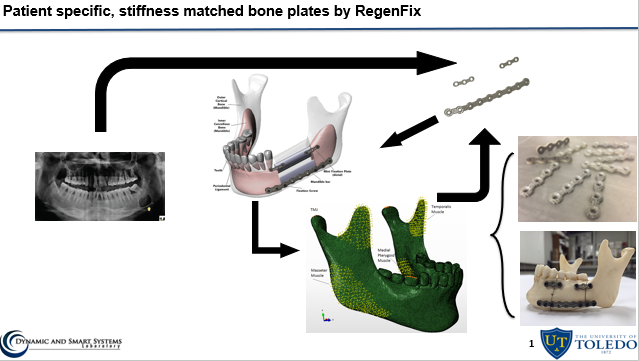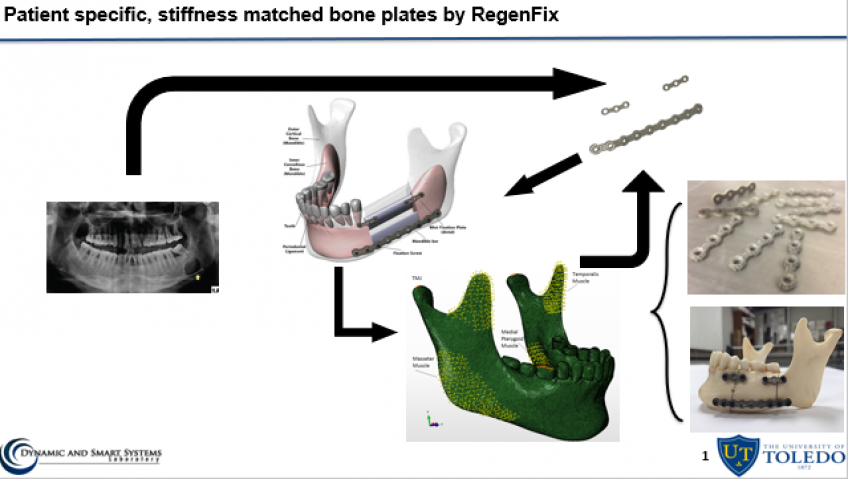Toledo, Ohio- The University of Toledo Institute of Applied Engineering Research (IAER) is working on advanced manufacturing with a focus on additive manufacturing. This venture is a result of the Adaptive Bio-Inspired Aerospace Structures Actuated by Shape Memory Alloys project led by the University of Toledo, The Ohio State University, and Case Western University and funded by the Ohio Federal Research Network (OFRN). The OFRN is a program managed by Parallax Advanced Research in collaboration with Ohio State and funded by the Ohio Department of Higher Education.
The research team at IAER, led by Advanced Manufacturing Director, Dr. Behrang Poorganji, is working on additive manufacturing and exploring its scope and applicability.
“Additive manufacturing is a new paradigm, a new era of manufacturing. Rather than designing and starting with casting and carving material into the desired shape, we build things layer-by-layer to the net shape. We are targeting that net-shape property in manufacturing,” said Dr. Poorganji.
The OFRN-funded shape memory alloy project focused on additive manufacturing of high-temperature shape-memory alloys and is now receiving funding from the Department of Energy through Oak Ridge National Laboratory (ORNL). The University of Toledo is working with ORNL on developing and promoting advanced manufacturing across industry and academia.
“With the support of the OFRN-funded project, our team became the first to successfully accomplish additive manufacturing of nickel titanium athenaeum. This achievement branched into commercialization and the development of a platform to connect academia and industry to collaborate on additive manufacturing challenges. It also led to the development of a new technology used in additive manufacturing of functional shape memory alloys,” said Dr. Mohammad Elahinia, director, IAER.
The platform that the IAER is working on will enable industries to efficiently interact with universities to result in a higher rate of technology maturation within the discipline of additive manufacturing.
“The platform allows industry to benefit from our experience with additive manufacturing at the university institute, from the infrastructure we are putting together and have put together, and from our talent and expertise. Then, when we bring industry and academia together to collaborate and tackle common challenges this results in increased competitiveness, technological edge, and profitability. And by bringing government agencies into this equation, industry and academia can collaborate on funding opportunities,” said Dr. Poorganji.
In addition to advancing technology, each OFRN-funded project contributes to developing the Ohio workforce. The University of Toledo invested in developing a fifteen-credit-hour mechatronics program with a focus on automotive mechatronics and a fifteen-credit-hour program on manufacturing, including manufacturing engineering, additive manufacturing, design of experiments, assembly and joining processes, design of manufacturability, and other elective options. A twelve-credit-hour program in material science and engineering is under review.
“Workforce development is very much driven by our industry and federal partners. These programs are designed and based on the current needs of the market and are created to provide workforce access to advanced training. We designed the programs to be flexible so that they can be completed in one semester or over multiple semesters, depending on the student’s availability. We have added similar content for our current students, so that when they graduate, they will be prepared to fulfill the critical needs of the workforce. Ultimately, our research led us to discover not only a new type of manufacturing but workforce needs, and with the right funding we can develop specific certification programs to cater to those needs,” said Dr. Poorganji.
The University of Toledo IAER team looks forward to working with its industry, academic, and government partners to advance additive manufacturing and educate and prepare the workforce on this new discipline. The University also continues to seek additional funding for its programs.
About Parallax Advanced Research
Parallax is a 501(c)(3) nonprofit that tackles global challenges by accelerating innovation and developing technology and solutions through strategic partnerships with government, industry and academia across Ohio and the Nation. Together with academia, Parallax accelerates innovation that leads to new breakthroughs. Together with government, Parallax tackles critical global challenges and delivers new solutions. Together with industry, Parallax develops groundbreaking ideas and speeds them to market.
About the OFRN
The OFRN has the mission to stimulate Ohio’s innovation economy by building statewide university/industry research collaborations that meet the requirements of Ohio’s federal laboratories, resulting in the creation of technologies that drive job growth for the State of Ohio. The OFRN is a program managed by Parallax Advanced Research in collaboration with Ohio State and is funded by the Ohio Department of Higher Education.
About University of Toledo Institute of Applied Engineering Research (IAER)
The IAER provides a gateway to access the world-class research facility at the University of Toledo. IAER’s areas of expertise include additive manufacturing, advanced bearing systems, advanced coating, MEMS and NEMS, biofluids, biomaterials, biomechanics and assistive technologies, computational fluid dynamics and aeroacoustics, icing detection and mitigation, fatigue and fracture, mechatronics and robotics, medical devices, metal forming and folding, micro- and nanomechanics, recycling, turbomachinery, and welding.






